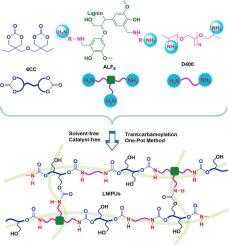绿色合成木质素基非异氰酸酯聚氨酯,作为可重复使用、自愈合和可移除的粘合剂
IF 5.8
2区 化学
Q1 POLYMER SCIENCE
引用次数: 0
摘要
木质素基非异氰酸酯聚氨酯(LNIPUs)是一类在不使用有毒异氰酸酯的情况下,从木质素(一种存在于植物细胞壁中的丰富的可再生聚合物)中合成的聚合物。这使得 LNIPU 成为传统石油基聚氨酯的环保型替代品。尽管 LNIPUs 具有诸多优点,但其合成过程通常比较复杂,需要使用额外的催化剂和高极性溶剂,这在很大程度上限制了其可获得性和实际应用。在本研究中,我们提出了一种高效、无催化剂和无溶剂的 LNIPU 合成方法。通过涉及胺化分馏木质素(ALFE)和双(6 元环碳酸酯)(6CC)的一锅式、无催化剂和无溶剂聚合反应,我们成功制备了一系列新型 LNIPU。我们系统地研究了所得 LNIPU 的特性,尤其关注其粘附性能。加入 ALFE 后,生成的 LNIPU 在铝、木材和塑料基材上的粘合性能明显增强,在铝基材上的最大粘合强度达到 3.09 兆帕。此外,LNIPU 还表现出卓越的功能性,包括可重复使用性、自愈能力和可移除性,以及更好的热稳定性和光热性能。本文章由计算机程序翻译,如有差异,请以英文原文为准。

Green synthesis of lignin-based non-isocyanate polyurethanes as reusable, self-healable and removable adhesives
Lignin-based non-isocyanate polyurethanes (LNIPUs) represent a class of polymers synthesized from lignin—an abundant, renewable polymer found in the cell walls of plants—without the use of toxic isocyanates. This makes LNIPUs an eco-friendly alternative to traditional petroleum-based polyurethanes. Despite their advantages, the synthesis of LNIPUs often entails complex processes, the use of additional catalysts, and highly polar solvents, which largely restrict their accessibility and practical applications. In this study, we present an higly efficient, catalyst-free, and solvent-free methodology for synthesizing LNIPUs. A series of novel LNIPUs were successfully prepared through a one-pot, catalyst-free and solvent-free polymerization reaction involving aminated fractionated lignin (ALFE) and bis(6-membered cyclic carbonate) (6CC). We systematically investigated the properties of the resulting LNIPUs, with a particular focus on the adhesion performance. The incorporation of ALFE significantly enhanced the adhesive properties of the resultant LNIPUs on aluminum, wood, and plastic substrates, achieving a maximum bonding strength of 3.09 MPa on aluminum. Furthermore, LNIPUs exhibit exceptional functionalities, including reusability, self-healing capabilities, and removability, along with improved thermal stability and photothermal properties.
求助全文
通过发布文献求助,成功后即可免费获取论文全文。
去求助
来源期刊

European Polymer Journal
化学-高分子科学
CiteScore
9.90
自引率
10.00%
发文量
691
审稿时长
23 days
期刊介绍:
European Polymer Journal is dedicated to publishing work on fundamental and applied polymer chemistry and macromolecular materials. The journal covers all aspects of polymer synthesis, including polymerization mechanisms and chemical functional transformations, with a focus on novel polymers and the relationships between molecular structure and polymer properties. In addition, we welcome submissions on bio-based or renewable polymers, stimuli-responsive systems and polymer bio-hybrids. European Polymer Journal also publishes research on the biomedical application of polymers, including drug delivery and regenerative medicine. The main scope is covered but not limited to the following core research areas:
Polymer synthesis and functionalization
• Novel synthetic routes for polymerization, functional modification, controlled/living polymerization and precision polymers.
Stimuli-responsive polymers
• Including shape memory and self-healing polymers.
Supramolecular polymers and self-assembly
• Molecular recognition and higher order polymer structures.
Renewable and sustainable polymers
• Bio-based, biodegradable and anti-microbial polymers and polymeric bio-nanocomposites.
Polymers at interfaces and surfaces
• Chemistry and engineering of surfaces with biological relevance, including patterning, antifouling polymers and polymers for membrane applications.
Biomedical applications and nanomedicine
• Polymers for regenerative medicine, drug delivery molecular release and gene therapy
The scope of European Polymer Journal no longer includes Polymer Physics.
 求助内容:
求助内容: 应助结果提醒方式:
应助结果提醒方式:


